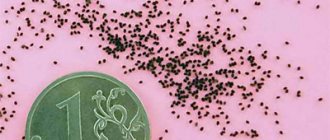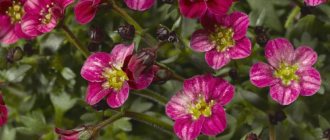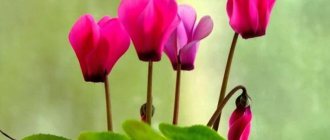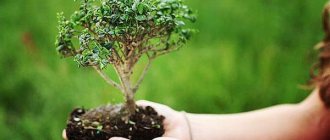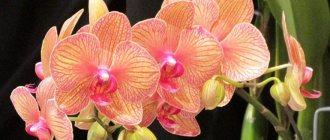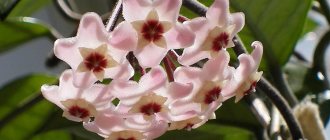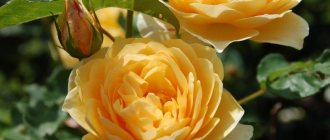Fatsia is an oligotypic genus of plants that belongs to the Araliaceae , which includes a small number of plant species. The scientific name of the genus was first used in 1854 by French botanists Joseph Dequenomy Jules Emile Planchon. It is derived from the Japanese name of the type species of the genus, Fatsia japonica.
This plant has been known as an ornamental since Victorian times (19th century). It has become widespread due to its unpretentiousness and rapid growth, which can be easily achieved by regular application of fertilizers and timely replanting. In just a couple of years, Fatsia is able to increase 1 m in height from a very small specimen.
Fatsia is a low shrub with highly decorative leaves, native to Japan, Taiwan and Vietnam, where it is widespread and can reach a height of 6 meters, forming a large spreading bush. In a home environment, Fatsia rarely overcomes the 1.5 meter barrier, but if you follow the basic rules for caring for the plant, it will delight you not only with a lush bush with carved leaves, but also with flowering.
At home, Fatsia japonica is mainly grown, but there are also garden species.
Fatsia japonica is a plant of the Araliaceae family.
Fatsia's closest relative is ivy. The plant has a very lush bush, which in free growth can reach up to 5 m in height. The stem tends to branch at the base, thereby increasing the volume of the bush.
Another distinctive feature that immediately catches the eye in the photo of Fatsia is the large leaves alternately inserted into the stem. They have a long petiole, membranous-lobed shape and are divided into 7-11 lobes. The classic variety has dark green leaves on the upper side, light green on the lower side, and can even reach 45 cm in width.
Fatsia varieties bred by amateur breeders can have golden foliage due to the minimized chlorophyll content (Anneliese variety) or a silver-green color (Shibori variety). Varieties of the Marginatis variety delight the eye with a gold or silver border.
The plant blooms in autumn, with typical umbrella inflorescences on the tops of the branches. Fatsia flowers are creamy white.
Botanical description
Fatsia (lat. Fatsia) is a monotypic genus belonging to the Araliaceae family - Fatsia japonica (Japanese fatsia) . Since 1910, a mixture between ivy and Fatsia - Fatshedera - has often been grown at home. House fatsia is often used to decorate pillars, walls and shop windows. The interiors are also decorated. Fatsias growing in pots decorate baskets. The plant can grow up to 1 m in height in just a couple of years if it is properly cared for and constantly fed. To form a beautiful crown, nothing should interfere with the plant.
Luxurious leaves of Japanese chestnuts
Fatsia received all her “folk” nicknames quite deservedly.
The foliage of this plant really most resembles the familiar chestnuts, only in a smaller copy, and with more beautiful textures. Fatsia came to us from distant Japan. It can safely be considered one of the most spectacular large-leaved shrubs among indoor crops. Fast growth and a luxurious crown are its main decorative advantages. This representative of the Araliaceae family has a rather modest varietal and species palette. fatsia japonica and its individual hybrids, forms and varieties are grown as an ornamental crop
Fatsia (Fatsia) is a decorative deciduous evergreen shrub and tree. Fatsias form very beautiful, neat-looking, albeit massive crowns. These naturally occurring tree crops in indoor format develop as low-branching shrubs with a maximum height of 2 meters, which, with proper care, are usually limited to a meter “format”. Fatsia has very thin shoots, which are not always able to cope with the mass of large leaves and often require additional support (this disadvantage is especially evident in variegated varieties). Visual volume and splendor are perfectly offset by the beauty of large foliage and a patterned effect that balances the dimensions and prevents the fatsia from negatively affecting the perception of the rooms. Fatsia leaves are its main pride. They sit on long petioles, palmately divided, large, up to 30 cm in diameter. A round or heart-shaped compound leaf contains 5 or 9 leathery lobes. The color of Fatsia leaves is by no means limited to an attractive and neutral dark green. The plant has numerous varieties and forms with borders and variegated spots. But all fatsias, without exception, are characterized by a glossy sheen and a beautiful texture of leathery foliage.
Fatsia, despite the ability to bloom in indoor culture, is a purely decorative deciduous plant. Many people call the flowering of Fatsia unremarkable, only spoiling the attractiveness of the bushes (the inflorescences are often removed from the plant on their own so that they do not even bloom). But since they do not affect the greenery, do not rush to do this. Small, inconspicuous greenish or white flowers are collected in miniature umbrellas of inflorescences, which, against the background of shiny large leaves, seem lacy and airy, a little reminiscent of dandelions. If you leave them on the plant, you can also admire the dark blue small berries, similar to black rowan, in which the seeds do not always ripen (and even if they ripen, they will quickly lose their germination capacity). There is no need to prepare fatsia for flowering, and it will not spoil the plant and will give it elegance.
Fatsia inflorescences. © Stephanie
Varieties and forms of fatsia
The best decorative forms and varieties of Japanese fatsia include:
- variety "Spider's Web" with silvery-gray leaves that from a distance seem to be carved from luxurious velvet;
- "Variegata" with an almost white-cream border on the leaves that unevenly creeps onto the plate;
- "Moseri" with an unusual, denser and bushier bush and a classic dark green color;
- "Aureimarginatis" - a form with an uneven bright yellow border;
- "Argenteimarginatis", decorated with an elegant white border that appears silver from a distance
Fatshedera Lizei (fatshedera Lizei), a hybrid of fatsia and ivy, is often included among the varieties of fatsia But today this plant is only being studied and it is more appropriate to consider it as a separate species.
Fatsia is a favorite among designers today. Unlike most indoor plants, it can grow equally effectively in different locations in the back of rooms; there is no need to display it only on window sills and near windows. This fashionable beauty is considered one of the cultures that are most appropriate to be introduced into modern interiors. But fatsia will not be lost in any style, equally organically creating the effect of “drowning in greenery”, and playing the role of an accent or space divider, feeling good at any height and in combination with any furniture. The beauty and effectiveness of the plant does not prevent it from remaining one of the best persistent indoor giants that any gardener can grow. Japanese chestnuts adapt well to different conditions, grow quickly, have almost no pronounced dormant period, and creating a cool winter is not at all necessary, although it is desirable. The only difficulty in growing fatsias is that they do not like drought and do not forgive long periods of lack of watering. But with modest regular care, they will surprise you with their unpretentiousness.
Fatsia japonica 'Moseri'. © Kyle Fatsia japonica 'Spider's Web'. © windyridge Fatsia japonica 'Variegata'. © dobbies
Fatsia is a crop considered one of the most poisonous indoor plants. When working with shrubs, especially during transplantation, it is necessary to fully protect the skin from contact with greenery and roots.
Dimensions of an adult plant
In open ground, fatsia reaches impressive sizes: its bush can be up to 6 m high. In enclosed spaces, it does not grow more than 2 m in height.
Most varieties and hybrids are large in size . However, there are also compact varieties that do not exceed 1 m. They are good for keeping in city apartments.
Growing fatsia
Fatsia japonica is a very unpretentious species. It is grown both in flowerpots and in open ground. When planted outdoors, the bush can withstand winter temperatures down to 0° C.
The plant does not tolerate direct sunlight well in the summer months, this can lead to rapid yellowing of the leaves. If you grow it indoors, you need to choose a room with good brightness, but not heated.
In winter, fatsia does not tolerate artificial heating well, so try to place it away from radiators and stoves. It is advisable not to allow the air to dry out in the room. When this plant suffers from inadequate environmental temperatures, its luxurious leaves first turn yellow, then droop and finally fall off.
Fatsia care at home
Briefly about cultivation
- Flowering: the plant is grown as an ornamental foliage plant.
- Lighting: Variegated varieties need bright, indirect light, while green-leaved varieties thrive in partial shade.
- Temperature: from spring to autumn – 17-21 ºC, in winter – 13-15 ºC. For variegated forms, the lower temperature limit is 16 ºC.
- Watering: during the period of active growth - as soon as the top layer of soil dries, and during a cool winter, you just need to prevent the substrate from drying out completely.
- Humidity: high. Regular spraying and washing of the leaves with a damp sponge is recommended.
- Feeding: during the growing season - every week with mineral or organic fertilizers. During cold wintering, the plant is not fed, and when fatsia is kept warm in winter, fertilizer is applied once a month.
- Pruning: in spring. Some types of fatsia require constant shortening of shoots.
- Replanting: once every three years in spring or early summer.
- Substrate: turf, leaf, humus soil and sand in equal parts.
- Reproduction: cuttings, seeds and layering.
- Pests: whiteflies, scale insects, spider mites and mealybugs.
- Diseases: due to improper care or violation of maintenance conditions, Fatsia develops problems with leaves.
- Properties: the Fatsia japonica plant is poisonous!
Lighting and location
- The green pet loves bright, (not sunny), cool places with a regular supply of fresh air. The place should be slightly shaded, with diffused light;
- An excellent location for the bush is the western or eastern side of the house;
- The variegated Japanese beauty needs sun, and varieties with leaves of the same shade stand well in the shade;
- In summer, an indoor flower can be placed outside, avoiding direct sunlight.
Humidity and watering
- In hot weather, the bush should be watered generously with clean, cool water. By autumn, the amount of water decreases;
- In winter, the “green resident” is watered less often and kept cool;
- When several hours have passed after moistening the soil, remove excess liquid from the pan, otherwise the roots of the bush will rot;
- If the soil dries out, the "southerner" may drop its leaves, and it will be extremely difficult to raise them again. For this purpose, special spacers are made and the leaves are tied horizontally;
- Caring for Fatsia at home involves maintaining high air humidity in your home. Spray the leaves with a spray bottle, if possible, carry out wet cleaning daily, wipe the leaves with a napkin.
Spraying fatsia
Large fatsia leaves require regular spraying with settled water, as well as wiping with a dampened soft cloth. In hot weather, the plant can be given a warm shower. In winter, you need to spray less often - it directly depends on the temperature in the room.
Optimal temperature for a flower
Indoors, the plant is grown at an optimal temperature of 20-22 degrees (in spring and summer). In winter, coolness and drafts should not be allowed, and the air is cooled to 10-16 degrees.
Fertilizers and soil requirements
- The luxurious Japanese plant is fertilized once every 10-15 days with mineral and organic fertilizers. Feed in the spring, summer, autumn seasons (except winter);
- The soil is turf and leaf soil, to which sand, humus and peat are added (1:1:1). A drainage layer is placed at the bottom of the pot.
Planting and transplanting
It is advisable to do this plant care work in early spring.
The soil for planting should be loose and permeable. Ready-made substrate is sold in stores. You can do it yourself: you need to take sand, peat and humus in proportion 1:1:1. Fatsia is planted in a deep, narrow pot.
Young Fatsias , whose root system grows intensively, are replanted annually.
Adult Fatsias are replanted once every two years, but additionally every year they remove a layer of topsoil and add fresh ones.
The Fatsia transplant process is very simple. Pour drainage into the transplant container. These are broken bricks, expanded clay, large pebbles, even crushed polystyrene foam will do. Drainage will take up one third of the height of the pot. Carefully, without destroying the soil around the root, transplant Fatsia into a larger container and fill it with fresh soil.
Fatsia pruning
Fatsia tolerates pruning well at home. To form a lush bush, you need to pinch the tops of the shoots of young plants. Fatshedera The face needs constant trimming.
Lifespan
This is a perennial species that, under favorable conditions, can live for decades. The bush is renewed thanks to annual pruning, which helps maintain its decorative appearance and enhances the growth rate.
In enclosed spaces, after 5-7 years of age, it is difficult to maintain the splendor of fatsia . Therefore, it is recommended to update it by rooting cut cuttings.
Soil, watering and fertilizers
Care at home is easy; regular watering and fertilization are enough. The Fatsia plant is not very picky about the type of potted soil and open ground. For potting, good garden soil mixed with 20% river sand is sufficient to improve drainage.
It is necessary to pay due attention to watering, which the plant may not have enough in the heat. The soil should always be kept well moist, with frequent watering in summer and less watering in winter.
Be careful not to overdo it, too much water can cause the leaves to lose their shape. Deciding how to water a flower and checking the moisture content is simple: touch the ground, it should be damp, but not saturated with water.
For those who grow fatsia in an apartment, there is a useful trick - from time to time, moisten the leaves with a spray. This way they will be shiny and bright green.
Periodic fertilization benefits plants, especially in spring and summer during vegetative growth. An excellent organic fertilizer for aralia is humus with earthworm humus.
Fatsia Japanese in the house: folk signs and superstitions
Fatsia japonica looks great in the house and is associated with many signs and superstitions. It decorates the halls and foyers of administrative buildings, spacious offices and retail premises, and greenhouses. The lush bush is popular for its rapid growth, attractive appearance in the interior, low maintenance, similar to dracaena. Large palmate leaves, which have a variety of colors depending on the variety, perfectly purify the air in the home and filter out harmful volatile substances.
INTERESTING TO KNOW! Fatsia is under the influence of Libra, an airy zodiac sign. Therefore, it effectively rids the air space not only of toxins, but also of negative energy.
According to legend, in the room where Fatsia is located, the atmosphere is cleared of accumulated heavy thoughts, rude and nervous words, and becomes pleasant, airily light. The plant must be purchased in a home where the inhabitants often experience emotional problems, are in a bad mood, suffer from depression, see life in gloomy colors, see no meaning in the future, and have no aspirations or hopes. It is recommended to have a fatsia for employees of offices and institutions where visitors constantly come with a negative attitude, troubles, and accumulated problems. After all, a negative attitude accumulates in the room and begins to negatively affect employees, which is why discord begins in the team.
There are many positive signs associated with fatsia.
Japanese bush:
- draws in bad energy accumulated from heavy thoughts and the gloomy mood of people;
- protects from troubles and bad consequences associated with the negative mental impact of guests and visitors;
- eliminates the desire to conflict, argue, quarrel, punish children;
- fills the home with calm energy conducive to peace and friendly relations;
- according to the sign, it improves marital relationships, prevents quarrels, omissions, relieves family members from being tired of each other, therefore it is called the “flower of family happiness”;
- extinguishes sudden attacks of nervousness and irritability.
Ruled by Libra, a large flower with spreading foliage is able to correct problems controlled by this zodiac sign regarding business and diplomatic relations. According to signs, the plant helps to acquire business acumen, helps a person build partnerships, present himself and his work in the best light. Therefore, it is recommended to place the “Japanese beauty” in offices and offices for employees who want to speak competently and convincingly and to win over partners and clients.
Where is the best place to place the plant?
Designers are very fond of the plant for its beauty and unpretentiousness. And if you take into account its cleansing psycho-emotional properties, then you can’t think of anything better . Fatsia grows well not only on the windowsill and goes well with different styles.
Based on numerous signs, they are happy to place it in the halls of administrative premises, offices, trading floors, and greenhouses . Regardless of color, the large feathery leaves of this plant remove harmful impurities and negative energy from the air.
Some concerns are raised by rumors about the toxicity of the stems and leaves of the “Japanese plant”. In fact, if the juice released is dangerous in any way, it is only an allergic reaction in a person or animal.
Some precautions wouldn't hurt:
- It is better to wear gloves when pruning and replanting plants;
- keep the pruned bush away from children;
- Handle fading flowers and developing ovaries carefully.
Fatsia japonica is a flower of family happiness. Its numerous varieties will fit perfectly into any style of home interior, clear the air of negative energy and improve the psycho-emotional climate in the house.
Reproduction of fatsia japonica
Fatsia japonica is easily propagated by seeds. The best time for planting is late spring, at a temperature of 10 to 15 ° C. The seeds are placed in small pots with a diameter of 10 cm for germination.
Seedlings that will never be exposed to direct sunlight should be replanted between September and October. After spending the winter in a cold balcony greenhouse, they will be transplanted to their place of growth in mid-late spring, that is, a year after sowing.
In general, spring is the ideal time to transplant fatsia. Do this regularly when the pot is too small to accommodate root development and plant energy. An improperly sized vase risks not keeping the bulky plant in balance.
If you want to take seeds from the plant, know that it blooms in early autumn. Therefore, the seeds ripen towards the end of November - beginning of December. Houseplants grown indoors bloom infrequently.
Aralia can also reproduce if you take root branches in March-April and place them in a 50% mixture of peat and sand.
How does the indoor flower Fatsia japonica reproduce?
There are three ways. Each of them is convenient in its own way and has disadvantages and advantages.
Propagation from seeds
Since it is very difficult to collect Fatsia seeds on your own, freshly purchased, purchased seeds are planted.
A special soil is taken for seedlings:
- Spray the soil, sprinkle some seeds on top and lay a layer of soil about 1 cm deep.
- Place the glass on top and place it in a lighted and insulated place. Remove the glass when shoots appear.
- When two true leaves appear, plant them in small plastic cups or directly into pots.
Germination of seeds
The main condition for the implementation of this propagation method is the integrity and safety of the seeds. They must have good germination.
First you need to choose the right substrate. To do this, take part of the soil, part of the sand and part of the turf. This will be the nutrient substrate for fatsia. It needs to be placed in containers and well moistened.
Fatsia is easy to propagate
The seeds are taken large, whole. They are sown sparsely and then covered with a thin layer of leaf soil. The containers are left in a warm place, covered with film (you can use glass).
When the plants sprout and 2-3 leaves appear on them, begin the picking process. The next stage is planting the plant separately in a pot.
Rooting cuttings
Of the vegetative propagation methods, the most common is using cuttings. The top part of the plant is cut off in the spring. The cuttings should still have swollen buds, preferably in the amount of 3. For speed, you can treat them with a special growth accelerator.
A mixture of peat and soil is placed in the container. You can also add a little sand there. The finished cutting is strengthened in this soil, preferably 2 cm deep. The optimum temperature is +26 degrees.
Attention! To create a greenhouse effect, the container with the cuttings is covered with a jar.
When the shoot takes root, you can plant a new plant in a separate pot.
Air layering
Growing using the following method takes longer and is more difficult. But at the same time, it is profitable and effective.
First you need to find two neighboring nodes closer to the top. A shallow vertically oriented cut is made on the stem.
It needs to be wrapped in wet moss. It is better if it is moistened with phytohormones or other growth stimulants. You can secure the moss to the trunk with foil. An alternative option is cling film.
The main condition is not to let the moss dry out. After about 30-60 days, roots appear at the site of the incision. After 30 days, you can cut the plant below the root level and replant. This way the Fatsia plant rejuvenates.
Pruning garden shrubs
Pruning Fatsia has decorative purposes and only serves to give the plant a more compact shape. The plant grows quickly and reaches a considerable size, so thin or elongated branches can be trimmed to make it look neater.
It is important to always make clean and precise cuts to avoid causing parts of the bush to dry out. The pruning tool must be cleaned and disinfected, and an incision made over the new bud. The best time for pruning is the end of winter.
Biological protection against parasites
Fatsia may suffer from the attack of various parasites, which worsen its appearance, also inhibit its growth and can lead to death. The periods of greatest risk are spring and summer.
Cotton cochineal
In spring, you need to pay attention to cochineal, which attacks the stems and lower parts of the leaves, sucking out the juice. Cochineal causes plant rotting and also promotes the formation of abundant honeydew and fumagin.
The insect can be killed using white mineral oil, which is allowed in organic farming and is only used on cochineal. Other remedies for this parasite are laundry soap, which also perfectly cleanses plants of honeydew, and fern macerate.
Aphid
Other problematic insects for Fatsia are aphids, which appear in mid-spring. These insects especially attack the leaves, making them sticky, and sucking out the juice.
To prevent its presence, we recommend using natural macerates such as garlic macerate and nettle macerate. If these are not enough and you are faced with an infection, you can use neem oil.
Fatsia diseases and pests
Spots on fatsia leaves. If you overdry the earthen ball, brown spots may appear on the leaves. Worse than this, the fatsia leaves will droop. It will be very difficult to lift them.
Fatsia leaves wrinkle. At very low air humidity, the fatsia leaf blade becomes brittle. And if there is still too much light, the leaves will wrinkle.
Fatsia leaves wither. If the plant is flooded, the leaves wither. If the plant is flooded regularly, the roots may begin to rot.
Fatsia pests. Often damaged by whiteflies and mealybugs, scale insects and spider mites.


